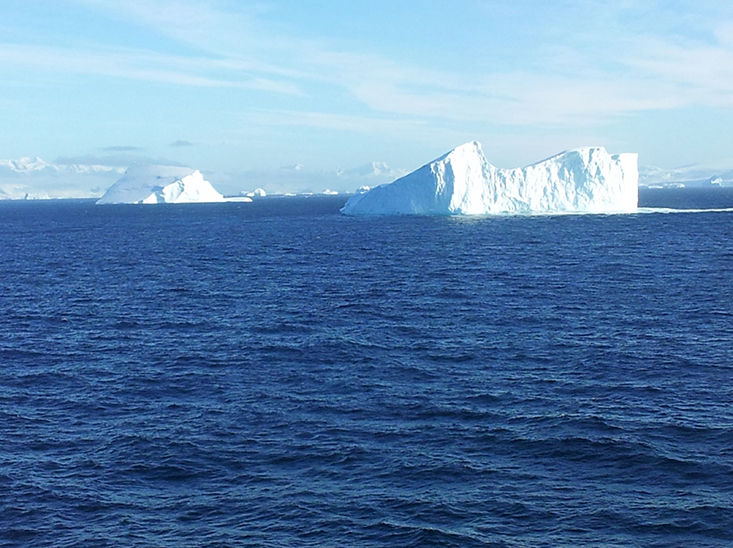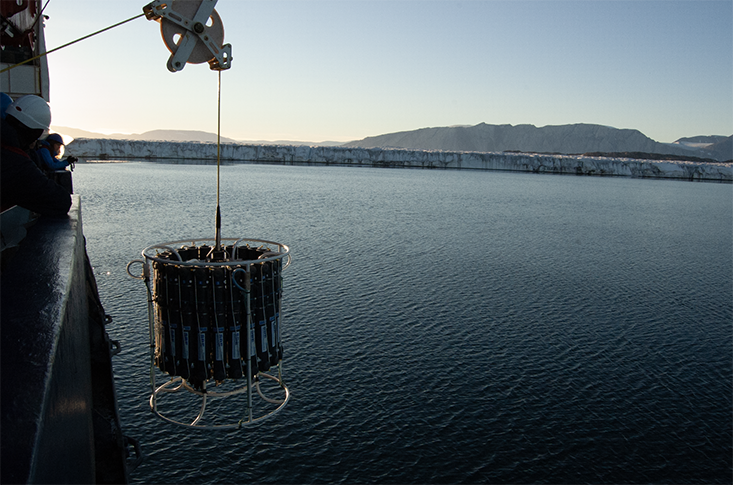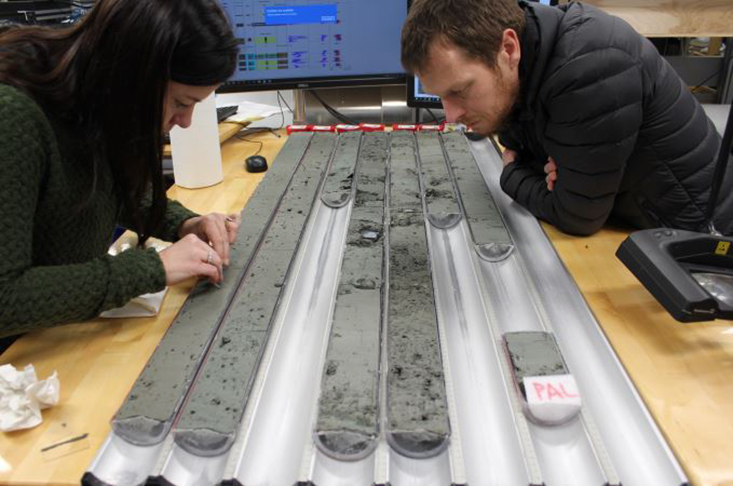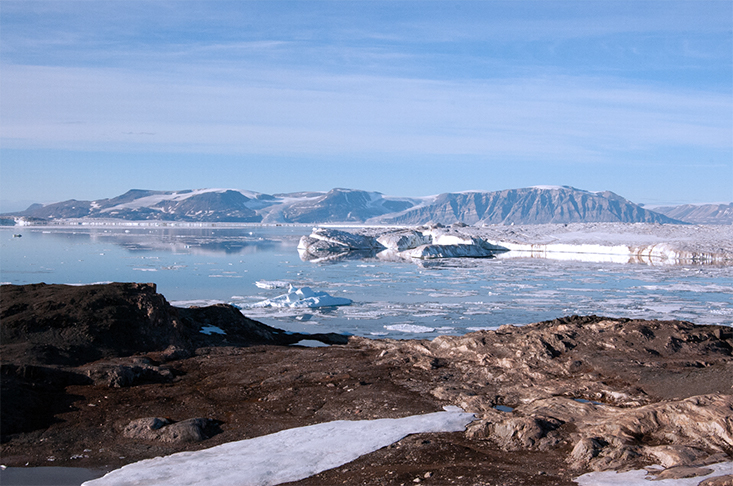Written by Tim Conway, Amelia Shevenell and Brad Rosenheim
Melting polar ice sheets play a pivotal role in changing global sea levels, and are expected to contribute to a six-inch rise in Florida sea level by 2030. But melting ice also provides an important and changing supply of nutrients to the oceans around Greenland and Antarctica. The Southern Ocean, which encircles Antarctica, also plays a vital global role in regulating heat, salt, carbon, and nutrient transfer between the oceans and atmosphere (taking up much of the global carbon emissions), and acts as a mix-master for all the oceans.
A group of USF CMS faculty and researchers who comprise ‘The Southern Ocean Science’ (SOS) group, carries out wide-ranging interdisciplinary research in Earth’s polar regions, providing new insights into how processes occurring thousands of miles away affect us here in Florida. This group, funded by the National Science Foundation (NSF) and National Oceanic and Atmospheric Administration (NOAA), has expertise in past climate and ice sheet history (Drs. Amelia Shevenell, Alistair Graham, Brad Rosenheim), nutrient and metal cycling (Drs. Kristen Buck, Tim Conway), ocean-atmosphere carbon dynamics (Dr. Nancy Williams), sea-level and Southern Ocean circulation change (Dr. Don Chambers), and polar marine ecology (Drs. Kendra Daly, Brad Siebel, Tom Frazer).
Enjoy these recent CMS polar research highlights:
Glaciers as nutrient sources in polar regions. Melting ice sheets, glaciers, and icebergs are key sources of iron to polar oceans, especially in the Southern Ocean, which has a limited supply of this essential nutrient. CMS Assistant Professor Dr. Tim Conway, Postdoctoral Researcher Dr. Matthias Sieber, and former graduate student, Brent Summers, recently published two papers on iron cycling in the Southern and Arctic Oceans:

Iceberg image Credit: Matthias Sieber
Writing last week in Earth and Planetary Science Letters (Sieber et al. 2021), Dr. Matthias Sieber and Dr. Tim Conway used the geochemical ‘fingerprint’ of iron in seawater to determine iron sources to the vast Southern Ocean, in collaboration with Swiss and Antarctic scientists as part of the Antarctic Circumnavigation Expedition.
This week, Dr. Tim Conway, CMS former graduate student Brent Summers and German collaborators also published an article in Nature Communications (Krisch et al., 2021). They found that processes occurring below Greenland’s floating ice shelves are essential for supplying nutrients to the oceans surrounding Greenland. Because glacial ice in Greenland is disintegrating quickly and unpredictably as temperatures warm, studies such as this one help us understand how regional ecosystems might be impacted with continued warming at both poles.

see Krisch CTD image Credit: Stephen Krisch
The Miocene as the key to the present. Marine mud collected from the continental shelves around Antarctica preserves records of Earth’s climate and Antarctica’s ice sheet evolution. In 2018, after more than a decade of planning, USF CMS Associate Professor Dr. Amelia Shevenell and her international collaborators set sail to the Ross Sea, Antarctica on International Ocean Discovery Program (IODP) Expedition 374. The researchers, including Shevenell and CMS graduate student Imogen Browne, recovered 1.5 kilometers of marine mud that contains 20 million years of climate and ice sheet history. Dr. Shevenell is interested in understanding how and why Antarctica’s ice sheets behaved during the early to middle Miocene (~17 to 12 million years ago), a warm climate interval when Earth’s atmospheric CO2 concentrations were similar to today and sea levels were higher.

Amelia Shevenell (IODP Expedition 374 lead sedimentologist) and Co-chief Rob McKay (Victoria University, New Zealand) examine sediment cores aboard the JOIDES Resolution in the Ross Sea Antarctica, 2018 (Photo by M. Leckie)
One of the first papers from Expedition 374, published recently in GSA Bulletin (Pérez et al., 2021), uses geophysical and marine sediment data to reconstruct Antarctica’s glacier and ice sheet behavior during the middle Miocene. The team found that during this warm climate interval, Antarctica’s glacial systems were much like those in present day Alaska. Around ~14 million years ago, the data suggests that Antarctica’s ice sheets expanded to close to their present size.
As a next step, Imogen Browne is reconstructing Miocene ocean and atmospheric temperatures in the Ross Sea to understand their role in past ice sheet behavior. Together, past ice sheet behavior and atmospheric temperature reconstructions are used in IPCC class global climate models to understand how Antarctica’s ice sheets will respond to future warming. This information improves scientist’s ability to predict the amount and rate of future sea level rise, critical information for the citizens of Florida.
Larsen C ice shelf history and future. Recent satellite observations have revealed the sensitivity of Antarctica’s fringing ice shelves, which stabilize Antarctica’s ice sheets, to climate and ocean warming. Such collapses, including the 2002 disintegration of the Larsen B ice shelf, on the eastern Antarctic Peninsula, and the 2021 calving of iceberg A-76 into the Weddell Sea, are increasingly common events as Earth’s climate warms. USF CMS Associate Professor Dr. Brad Rosenheim, and former CMS graduate student, Dr. Cristina Subt, were part of an international team working to reconstruct the history of the Larsen C ice shelf over the last 10,000 years. Writing recently in the journal Geology, Smith et al. (2021) found that the Larsen C ice has retreated in size during past warm periods, but never completely collapsed like other regional ice shelves further north. Will Larsen C survive future warming that is predicted to be unprecedented in the last 10,000 years? The jury is still out.
Stay tuned for more exciting work on the polar regions by researchers at CMS.
